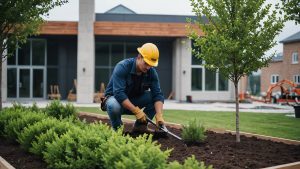
Introduction
Architecture has long been seen as the art and science of shaping buildings, but in recent decades, that vision has expanded to include a more holistic approach—one that doesn’t stop at the walls of a structure. As cities become denser and climate concerns grow more pressing, the boundaries between indoor and outdoor spaces are blurring. The result is a new movement that seeks harmony between human-made environments and the natural world.
Rethinking the Relationship Between Structures and Surroundings
Traditionally, buildings have been designed with a primary focus on function and form, often treating outdoor spaces as secondary. However, a growing appreciation for nature’s psychological and environmental benefits has led architects and planners to rethink this approach. Now, the emphasis is not only on how a building serves its occupants, but also on how it interacts with its surroundings.
Incorporating greenery, water features, natural light, and ventilation is no longer a luxury—it’s a necessity. Studies show that access to nature can reduce stress, improve air quality, and boost productivity. By integrating these elements early in the planning process, architects are creating spaces that are not only beautiful but also healthier and more sustainable.
Designing with Purpose and Place in Mind
Each site tells a different story, shaped by its geography, climate, and cultural context. The best designs are those that respect and respond to these local conditions rather than override them. This means working with natural topography, selecting native plants, and aligning structures to take advantage of sun paths and prevailing winds.
Contextual design also takes into account how people use space throughout the day and across the seasons. Flexible layouts, shaded pathways, and open courtyards are just a few ways designers are ensuring year-round usability while keeping aesthetics and sustainability in focus.
The Integration of Outdoor Aesthetics and Architecture
An essential part of this evolution involves collaborative work between architects, landscape designers, and engineers. One of the emerging focal points in this multidisciplinary effort is landscaping building design—a process that marries the built environment with thoughtful green space planning. It’s about creating a seamless transition from indoor comfort to outdoor serenity, often using materials, colors, and forms that complement both realms.
These designs can include anything from green roofs and vertical gardens to integrated rainwater harvesting systems and eco-friendly paving. Not only do these features enhance visual appeal, but they also contribute to biodiversity, stormwater management, and microclimate regulation.
Urban Applications and Public Impact
This integrated approach is gaining particular traction in urban environments, where green space is at a premium. Cities around the world are reimagining public parks, rooftops, and even alleyways as extensions of the built environment. Projects that prioritize outdoor integration have been linked to increased community engagement, improved mental health, and even economic growth through tourism and higher property values.
Green infrastructure in urban settings also helps counteract the heat island effect, where concrete-heavy areas become significantly warmer than their surroundings. By softening the urban fabric with vegetation and permeable surfaces, cities can become more livable and climate-resilient.
Challenges and Considerations
Despite its growing popularity, designing with nature in mind does present certain challenges. Budget constraints, maintenance demands, and local regulations can all impact what’s possible. Moreover, achieving a true synergy between a building and its landscape requires close collaboration and detailed planning from the very beginning of a project.
There is also the risk of greenwashing—where superficial or decorative greenery is added for aesthetics alone, without delivering real environmental benefits. To avoid this, professionals must prioritize function and ecological integrity alongside visual design.
Conclusion
Architecture is no longer just about shelter; it’s about shaping experiences and fostering connections—to place, to people, and to nature. As we move toward a future that demands sustainability and adaptability, the integration of built forms with the natural world will continue to define thoughtful design. Whether for private homes, public institutions, or commercial developments, the key lies in a balanced approach that respects both structure and landscape. In doing so, we not only enhance our environments—we enrich our lives.
